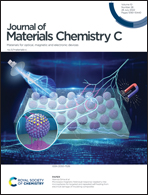A triphenylamine-based Pt(ii) metallacage via coordination-driven self-assembly for nonlinear optical power limiting†
Abstract
The past several decades have witnessed the rapid development of high-intensity and ultrashort pulse lasers, and the risk of accidental damage to optical detection systems has increased commensurately. Thus, various optical limiting mechanisms and materials have been proposed. Here, we demonstrate a 3D metallacage that was designed and synthesized via the coordination-driven self-assembly of triphenylamine cores and complementary Pt(II)-based components. The novel metallacage was fully characterized by NMR and ESI-TOF-MS, and its structure was determined by a single crystal X-ray diffraction study. The metallacage showed bright orange luminescence and a large two-photon absorption cross-section of 2010 GM at 750 nm that was about 2.4-fold that of the ligand. The enhanced multiphoton-excited photoluminescence (MEPL) of the metallacage compared with that of its organic ligand is attributed to the coordination facilitated aromatic π-extension and rigidifying effects in the metallacage. Furthermore, the metallacage solution presented the transmittance reduction effect which was nonlinearly dependent on the input energy intensity, making it a potential candidate for the construction of future optical power limiting (OPL) devices.



 Please wait while we load your content...
Please wait while we load your content...